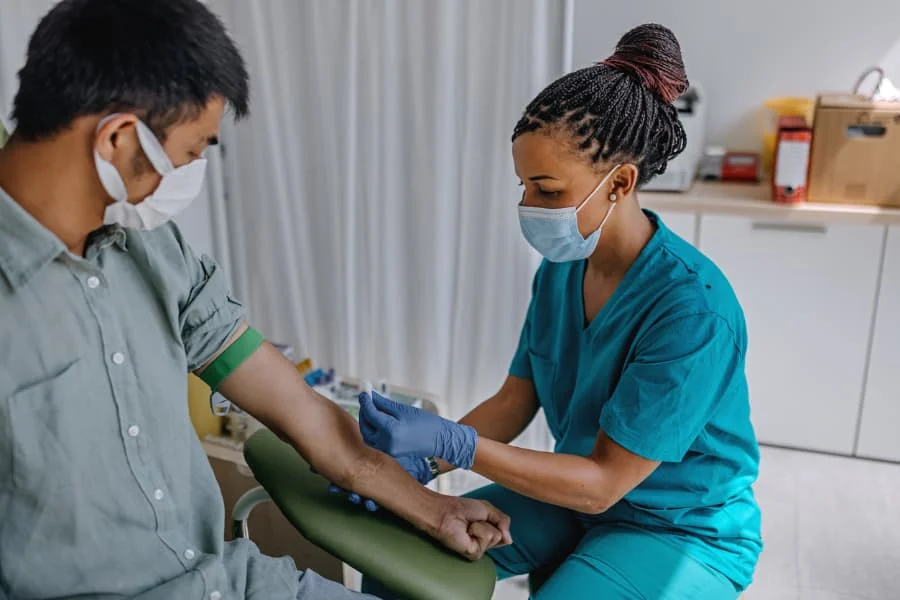A traveling or mobile phlebotomist provides a valuable healthcare service. Their job involves drawing blood from patients at home, care facilities, workplaces, and remote areas and delivering samples to a laboratory for analysis. Becoming a traveling phlebotomist requires training and on-the-job experience. You can gain this experience by working at a local lab, blood drive, or through a phlebotomy training program that offers internship opportunities.
Collecting Blood Specimens
For patients with disabilities, limited mobility, or other issues that prevent them from traveling to a lab for blood draws, a mobile phlebotomist is the answer. Using their training and equipment, they can travel to locations where people need lab services without leaving home or work. Before departing to collect samples, a mobile phlebotomist ensures they have the correct paperwork and patient identification to complete their duties. They also provide the proper equipment, such as a needle and tube. Additionally, they should be able to calm patients who are nervous or fear needles and blood. Depending on the client, they may be required to provide education on adequately preparing for their appointment, such as fasting for 12 hours or wearing loose clothing.
Other responsibilities of a traveling phlebotomist include arriving at each location on time and maintaining accurate records. They must also safely transport the collected samples to a lab for processing. Excellent interpersonal communication skills are essential as they must interact with doctors, nurses, and people daily. If they own their own business, a travel phlebotomist must understand how to set up and manage all necessary equipment and storage facilities.
Maintaining Patient Records
A mobile phlebotomist keeps detailed records of all samples and procedures. They also ensure they collect blood samples from the correct patient and deliver them to the proper laboratory. Other responsibilities include:
- Preparing specimens for transport.
- Labeling samples according to specific protocols.
- Disposing of used items such as syringes.
In addition, mobile phlebotomists are required to keep track of all supplies and equipment they use. It includes ensuring sufficient blood draw kits, storage containers, and transport supplies to meet their appointments. They also need to ensure they have a reliable vehicle, can haul the necessary equipment and supplies, and are sanitized for each location they travel to. If a traveling phlebotomist wants to make the most of their career, they should consider an externship to gain experience and prove themselves. It will allow them to learn to perform all aspects of their job, including working with patients. It will also provide them real-world experience that employers love seeing on a resume. A traveling phlebotomist works as an independent contractor for a local lab or medical organization or can work for themselves as a 1099 contractor. Either way, it is essential to take the necessary steps to set themselves up properly as a business, including registering with your state, obtaining a tax ID number, purchasing appropriate business insurance, and opening a bank account for the company.
Communicating With Patients
A phlebotomist draws blood for testing or blood donation, so they must be able to communicate with patients to gather the necessary information. It includes explaining what to expect during the process and educating patients on how to prepare beforehand, such as fasting for 12 hours. They also work to calm patients nervous or fearful of needles or blood. The phlebotomist must also maintain a high level of professionalism during patient interactions. They must wash their hands before and after each visit and ensure they wear gloves during the procedure.
Additionally, they must enter the proper data into the EMR system for each patient, including insurance information and clinical notes. If you want to become a traveling phlebotomist, enroll in an accredited phlebotomy program. Many programs include an externship to provide valuable real-world experience before you search for travel positions. It will support you in establishing a solid professional base and getting your foot in the door.
Keeping Areas Clean
Phlebotomists need to adapt to new locations and quickly sanitize their working areas. Hospital phlebotomists benefit from a designated place to work, but traveling phlebotomists must be able to adjust and keep up with cleanliness standards. Depending on your career goals and the level of flexibility you’re looking for in your job, there are different pathways you can take to become a traveling or mobile phlebotomist. Some people choose to become a phlebotomist straight out of high school, while others pursue a degree in medical assisting or a related subject before completing a phlebotomy course. If you’re serious about becoming a traveling phlebotomist, you can find a phlebotomy training program near you and enroll today.
Another way to start your journey as a traveling phlebotomist is to volunteer or work at blood drives and community events that help keep local hospitals running smoothly. It is a great way to build up experience in the field and prove you have the right skills and attitude for the job. You can also speak with a healthcare recruiter to find out about opportunities for working as a traveling phlebotomist and ask about the kind of experience you’ll need to get the job you want. Becoming a mobile phlebotomist isn’t as complicated as you might think, and this work has many benefits.

